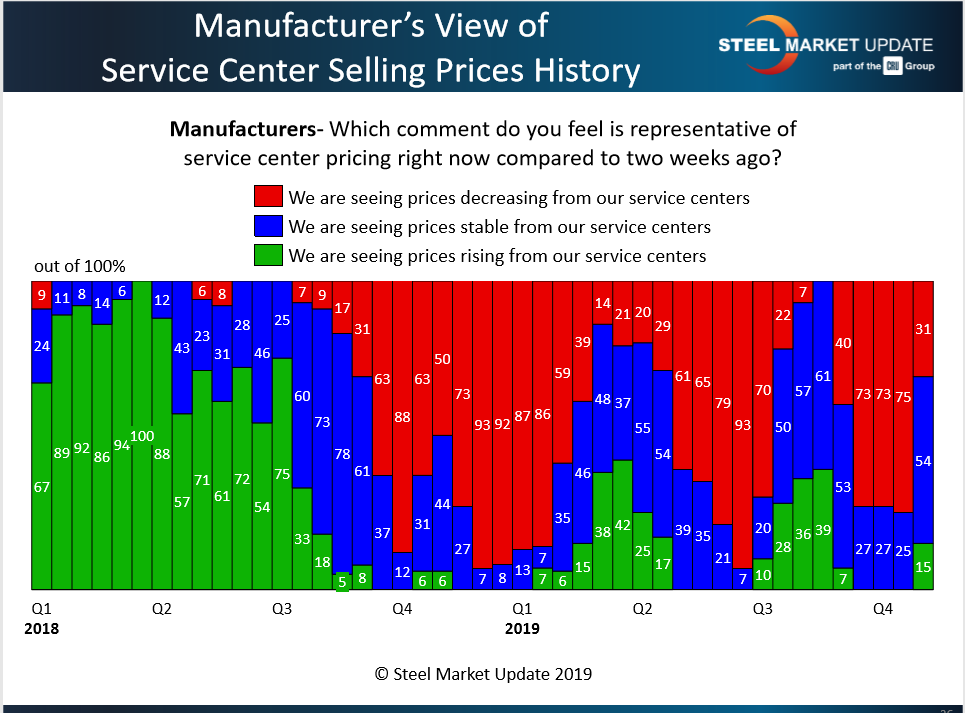SMU Data and Models

Service Centers Reach "Capitulation" and Begin to Support Higher Prices
Written by John Packard
November 12, 2019
Flat rolled steel prices are on the way up following two recent rounds of price increases. Steel Market Update has been anticipating the turnaround in prices as the market has been near the point of “capitulation” for several weeks. Capitulation is the point when 75 percent or more of our service center survey respondents are reporting their company as lowering spot pricing to their end customers compared to what they were doing just two weeks prior. The stress on inventory values and margins puts distributors at a psychological point where they will support price increase announcements when made by the domestic steel mills. What we are seeing, having reached the point of capitulation over the past six weeks, steel mills raised prices and now the service centers are beginning to support higher prices. However, our data does not suggest full support – yet….
The data shown in the graphics below come from last week’s SMU Flat Rolled and Plate Steel Market Trends survey. We invited 460 steel people to provide their insights into the flat rolled and plate steel markets, and what factors are influencing steel prices, demand, supply, etc.
The chart below (Service Center View of Selling Prices History) shows the two $40 price hikes by market leader Nucor, one in late October and the other in early November, which were matched by most other mills. Data gathered by SMU today indicates that at least part of the $80 in increases is sticking. The average benchmark price for hot rolled steel is now around $520 per ton, up from $470 per ton in mid-October.

Since the beginning of October, as many as 89 percent of service centers have reported lowering spot prices to their customers. Nearly the same percentage of manufacturers, 73-75 percent, confirmed the price cutting by their distributor sources (see Manufacturers View of Service Center Selling Prices History chart below).

In tight, competitive market conditions, service centers often discount spot prices to win orders, even though they know reducing prices erodes the value of their inventories. History has shown that when at least 75 percent of the service centers have been lowering prices, and the mills announce a price increase, the service centers will “capitulate” and begin to support higher prices in pursuit of better margins.
What the data does not show is how much support the mills will receive from distributors as they attempt to collect higher prices or how long before the service centers begin to discount once again. Perhaps predictive of the staying power of the latest price hike, only about one-third of the service centers polled last week said they were actively raising prices, while the majority were keeping prices the same.

John Packard
Read more from John PackardLatest in SMU Data and Models

SMU Survey: Sheet lead times ease further, plate hits one-year high
Steel buyers responding to this week’s SMU market survey report a continued softening in sheet lead times. Meanwhile, plate lead times have moderately extended and are at a one-year high.

SMU Survey: Buyers report more price flexibility from mills
Nearly half of the steel buyers responding to this week’s SMU market survey say domestic mills are showing increased willingness to negotiate pricing on new spot orders. This marks a significant shift from the firmer stance mills held in prior weeks.

SMU Survey: Buyers’ Sentiment Indices fall
Current Sentiment Index dropped six points to +42 this week compared to two weeks earlier. It has fallen in every successive survey since reaching a 2025 high of +66 on Feb. 19.

March service center shipments and inventories report
Steel service center shipments and inventories report through March 2024.

Apparent steel supply contracts in February
The amount of finished steel that entered the US market in February receded from January’s peak, according to our analysis of Department of Commerce and American Iron and Steel Institute (AISI) data.
